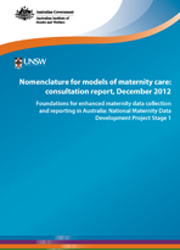Summary
The National Maternity Data Development Project seeks to develop a standardised nomenclature for maternity models of care that will enable current and future models of care provided in Australia to be identified and described. Following the findings of a literature review, the Nomenclature for Models of Care Working Party approved one of three
proposed solutions for classifying models of care using a data framework combined with a set of defined Major Model Categories (MMCs). This proposed solution, known as the Maternity Care Classification System (MaCCS), was then presented at a series of consultation forums in each jurisdiction as well as at a national workshop that reviewed proposed amendments from the jurisdictional forums. Following consensus at the national workshop on all proposed changes, the resulting data items and MMCs were sent out for further consultation via an electronic survey instrument.
A total of 98 participants attended the consultation forums held in each state and territory and over 360 people responded to the electronic survey. Feedback was received from a wide range of stakeholders including obstetricians, midwives, general practitioners, consumers, policy-makers, data managers, neonatologists, researchers and academics. Feedback was overwhelmingly positive. All stakeholder groups acknowledged the need for a classification system that would capture the different characteristics of models of care without relying solely on the name of the model. The results of the consultation echoed the findings of the literature review-that there were too many differences between models of care sharing the same category or name for a simple naming system to be effective in identifying models of care for evaluation or reporting.
Forum participants and survey respondents supported collecting data about characteristics of models of care at the institutional rather than the individual level to reduce the burden on clinicians. Using the MaCCS annually at a hospital to create the 'model of care' codes will make data collection easier. Nonetheless, there were still some concerns about when the model of care would be recorded for each woman, given the retrospective nature of the Perinatal Data Collection forms. Without the use of a shared electronic antenatal record, recording practices for the model of care during the antenatal period and changes to the model may be variable and these data may not be accessible to the midwife at birth, which could result in inaccurate data.
The content of the proposed MaCCS was improved and refined as a result of consulting [or consulting and engaging with] all relevant stakeholder groups. This resulted in a more robust and workable set of model characteristics. The positive feedback from the consultation process confirms that the proposed MaCCS should be progressed as the most suitable tool to define and record models of maternity care in Australia.



